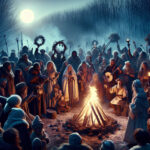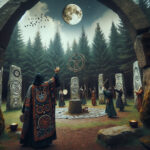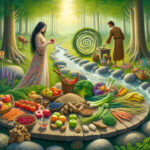The winter solstice, or Yule, is a time of celebration, reflection, and renewal. It marks the longest night of the year, and the return of the sun after the longest night. Pagan Yule is an ancient tradition, steeped in folklore and myth, that has been passed down through generations. This article will explore the history of Pagan Yule and how it has evolved through the ages. We will discuss the origins and traditions of Pagan Yule, how it is celebrated today, and the impact it has had on modern holiday traditions.
Pagan Yule is an ancient celebration of the winter solstice, and one of the oldest and most important festivals in the Pagan calendar. It is a time to celebrate the end of the old year and the beginning of the new, and to reflect on the past while looking forward to the future. The festival is traditionally celebrated on the winter solstice, which is the shortest day and longest night of the year, and marks the moment when the Sun reaches its lowest point in the sky.
History of Pagan Yule
Pagan Yule is a celebration of the winter solstice, which is the shortest day and longest night of the year. It is an ancient festival that has been celebrated for centuries, and is thought to have originated in pre-Christian Europe. In ancient societies, the winter solstice was seen as a time of rebirth and renewal, and was seen as a time to honor the gods and goddesses.
Yule was an important festival in pre-Christian Europe, and was celebrated by many cultures, including the Celts, Norse, and Germanic tribes. It was seen as a time of rebirth and renewal, and was celebrated with feasting, drinking, and gift-giving. In some cultures, it was seen as a time to honor the gods and goddesses, while in others it was seen as a time to honor the dead.
Symbols of Pagan Yule
Pagan Yule is associated with a number of symbols that are associated with the winter solstice, rebirth, and renewal. These symbols include evergreens, holly, mistletoe, and the yule log. Evergreens are often used to decorate homes and churches during the Yule season, as they are thought to symbolize strength and life in the face of winter. Holly is also a popular Yule decoration, as it is thought to represent the holly king, who is believed to be the ruler of the winter solstice. Mistletoe is also popular, as it is believed to bring luck and good fortune to those who kiss beneath it. The yule log is another popular symbol of Yule, and is often burned in the fireplace to bring warmth and light to the home.
Yule Traditions
Yule is celebrated with a variety of traditions that have been passed down through the generations. One of the most popular Yule traditions is the yule log, which is burned in the fireplace to bring warmth and light to the home. Another popular tradition is the yule feast, which is a feast to honor the gods and goddesses. Feasts often include traditional dishes such as pork, beef, or turkey, and are accompanied by special drinks such as mulled wine or eggnog.
Gift-giving is also an important part of Yule traditions. This is often done in the form of small gifts, such as candles, jewelry, or sweets. These gifts are given to honor the gods and goddesses, and to bring luck and good fortune to the recipient.
Modern Pagan Yule Celebrations
Yule is still celebrated by modern Pagans, who usually combine ancient traditions with modern practices. These celebrations often include decorating the home with evergreens, holly, and mistletoe, and burning the yule log in the fireplace. Feasting and gift-giving are also popular activities, as is the honoring of the gods and goddesses. Modern Yule celebrations also often incorporate rituals, such as the burning of incense, chanting of prayers, or reading of poems or stories.
Pagan Yule is a time of renewal and rebirth, a time to celebrate the end of the old year and look forward to the new. It is a time to honor the gods and goddesses, and to reflect on the past while looking forward to the future. As such, it is an important festival in the Pagan calendar, and one that has been celebrated for centuries.
The celebration of Yule has been around for centuries, and it has served as a way for people of different cultures to come together and celebrate the winter season. It is a time to remember the past and look forward to the future with hope and optimism. Yule is a time to celebrate the winter solstice, and to remember the importance of family, friends, and the natural world. It is a time for joy, gratitude, and reflection. As we continue to celebrate Yule, we should remember its rich history and all that it stands for. Yule is a time to celebrate the beauty and joy of the season, and to honor the traditions of our ancestors.





